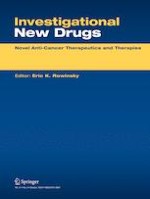Erschienen in:

15.07.2023 | Research
Pharmacological assessment of the antineoplastic and immunomodulatory properties of a new spiroindolone derivative (7’,8’-Dimethoxy-1’,3’-dimethyl-1,2,3’,4’-tetrahydrospiro[indole-3,5’-pyrazolo[3,4-c]isoquinolin]-2-one) in chronic myeloid leukemia
verfasst von:
Carlos Eduardo de Castro Alves, Serge L. Bogza, Nathalie Bohdan, Alexander B. Rozhenko, Alice de Freitas Gomes, Regiane Costa de Oliveira, Renata Galvão de Azevedo, Larissa Raquel Silva Maciel, Anamika Dhyani, Andriy Grafov, Gemilson Soares Pontes
Erschienen in:
Investigational New Drugs
|
Ausgabe 5/2023
Einloggen, um Zugang zu erhalten
Abstract
The discovery and development of effective novel compounds is paramount in oncology for improving cancer therapy. In this study, we developed a new derivative of spiroindolone (7’,8’-Dimethoxy-1’,3’-dimethyl-1,2,3’,4’-tetrahydrospiro[indole-3,5’- pyrazolo[3,4-c]isoquinolin]-2-one) and evaluated its anticancer- and immunomodulatory potential in a vitro model of chronic leukemia. We utilized the chronic leukemia cell line K562, as well as non-cancerous peripheral blood mononuclear cells (PBMC) and Vero cells (kidney epithelium of Cercopithecus aethiops). We assessed the cytotoxicity of the compound using the MTT assay, and performed cell cycle assays to determine its impact on different stages of the cell cycle. To evaluate its antineoplastic activity, we conducted a colony formation test to measure the effect of the compound on the clonal growth of cancer cells. Furthermore, we evaluated the immunomodulatory activity of the compound by measuring the levels of pro and anti-inflammatory cytokines. The study findings demonstrate that the spiroindolone-derived compound exerted noteworthy cytotoxic effects against K562 cells, with an IC50 value of 25.27 µg/mL. Additionally, it was observed that the compound inhibited the clonal proliferation of K562 cells while displaying minimal toxicity to normal cells. The compound exhibited its antiproliferative activity by inducing G2/M cell cycle arrest, preventing the entry of K562 cells into mitosis. Notably, the compound demonstrated an immunomodulatory effect by upregulating the production of cytokines IL-6 and IL-12/23p40. In conclusion, the spiroindolone-derived compound evaluated in this study has demonstrated significant potential as a therapeutic agent for the treatment of chronic myeloid leukemia. Further investigations are warranted to explore its clinical applications.











